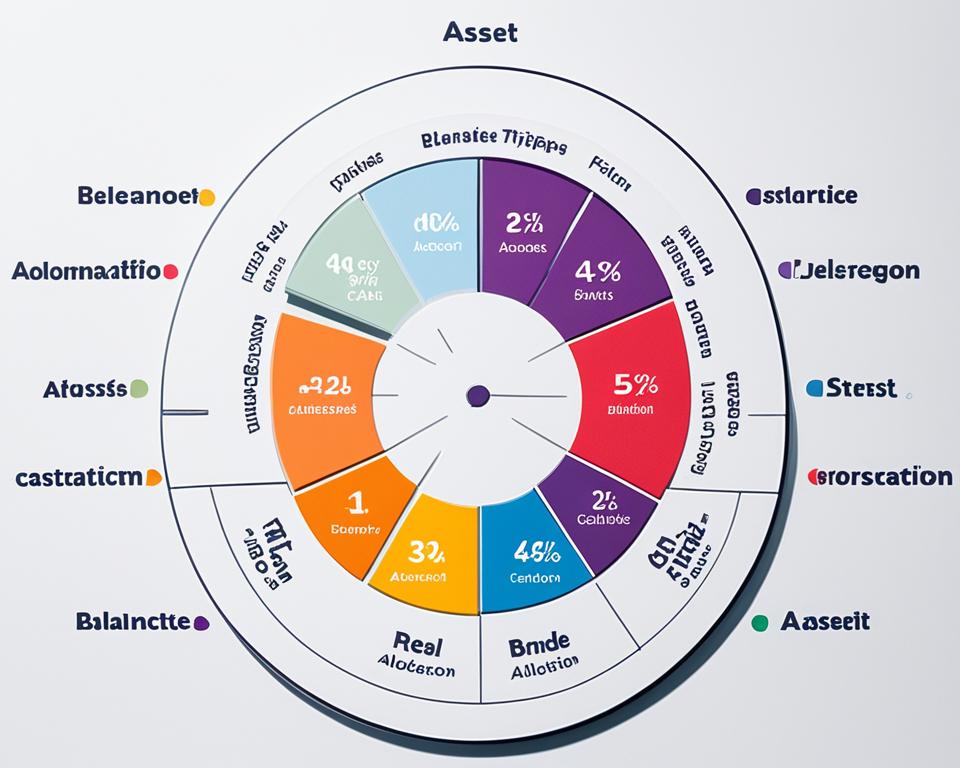Asset allocation is a crucial technique for optimizing investment strategies and securing financial futures. It involves dividing investments among different categories such as cash, bonds, stocks, real estate, and derivatives to balance risk. Understanding the following five key aspects of asset allocation is essential for successful investing:
Key Takeaways:
- Implementing asset allocation strategies is crucial for optimizing investment portfolios.
- Diversification in asset allocation helps to manage risk and enhance portfolio performance.
- There are different asset allocation models to choose from based on individual goals and risk tolerance.
- Customizing asset allocation is necessary to align with personal circumstances and financial goals.
- Regularly reviewing and rebalancing the asset allocation portfolio is essential to maintain desired risk and return levels.
What is Asset Allocation?
Asset allocation is a powerful investment strategy that aims to balance risk and optimize portfolio performance. It involves diversifying investments across various asset categories, including cash, bonds, stocks, real estate, and derivatives. Each asset class offers different levels of return and risk, allowing investors to create a well-rounded and resilient portfolio.
By diversifying investments across different asset categories, asset allocation helps manage risk and reduce the impact of market fluctuations. This strategy ensures that the portfolio is not overly concentrated in a single asset class, thereby mitigating the potential losses associated with a downturn in a specific industry or market segment.
Here is an overview of the major asset categories in asset allocation:
- Cash: Cash equivalents, such as savings accounts, money market funds, and certificates of deposit, provide liquidity and stability to a portfolio.
- Bonds: Fixed income securities, including government bonds, corporate bonds, and municipal bonds, offer regular income and are comparatively less volatile than stocks.
- Stocks: Equities represent ownership in companies and offer the potential for long-term capital appreciation. However, they also come with higher volatility and risk.
- Real Estate: Real estate investments can include residential properties, commercial properties, real estate investment trusts (REITs), and real estate funds.
- Derivatives: Derivatives, such as options and futures contracts, are financial instruments whose value is derived from an underlying asset. They can be used to hedge risk or capitalize on market movements.
Each asset category serves a unique purpose and contributes to the overall risk and return profile of the portfolio. Effective asset allocation involves determining the optimal mix of these asset categories based on an investor’s goals, risk tolerance, and investment timeline.
“Asset allocation is like a chef combining different ingredients to create a delicious and balanced dish. By carefully selecting the right proportions of each asset category, investors can create a portfolio that is well-suited to achieve their financial objectives.” – [Author Name]
It’s important to note that asset allocation is not a one-time decision but an ongoing process. As market conditions change and personal circumstances evolve, it may be necessary to periodically rebalance the portfolio to maintain the desired asset allocation. Regular review and adjustment ensure that the investments stay aligned with the investor’s goals and risk tolerance.
Risk vs. Return
The risk-return tradeoff is a fundamental concept in asset allocation. While everyone wants high returns, it’s important to consider the relationship between risk and return. Investing solely in assets with high potential returns, such as stocks, can be risky.
Asset allocation allows investors to allocate more money to higher-risk assets like stocks if they have a higher risk tolerance. However, it’s crucial to evaluate one’s ability to withstand short-term market fluctuations and adjust asset allocation accordingly.
“The key to successful asset allocation is finding the right balance between risk and return.”
Understanding the Risk-Return Tradeoff
When it comes to investing, higher risk is typically associated with the potential for higher returns. Risk refers to the possibility of losing money or earning lower-than-expected returns on an investment. Return, on the other hand, is the gain or loss generated from an investment over a specific period of time. The risk-return tradeoff implies that to earn higher returns, investors must be willing to accept greater risk.
In asset allocation, balancing risk and return is crucial. Investors should analyze their risk tolerance, considering factors such as their overall financial situation, investment goals, time horizon, and personal comfort level with market volatility. By aligning their asset allocation strategy with their risk tolerance, investors can strike an optimal balance between potential returns and the level of risk they are willing to bear.
The Importance of Balancing Risk and Return
Properly balancing risk and return in asset allocation is essential for several reasons:
- Diversification: Allocating investments across different asset classes helps to spread risk and minimize the impact of any single investment’s poor performance.
- Stability: A well-diversified portfolio with a balanced risk-return ratio can provide stability during market downturns, protecting investors from significant losses.
- Long-Term Growth: By carefully considering risk and return, investors can position their portfolios for consistent long-term growth while minimizing unnecessary exposure to excessive risk.
Balancing Risk and Return Strategies
There are various strategies investors can employ to balance risk and return in asset allocation:
- Asset Class Diversification: Spreading investments across different asset classes, such as stocks, bonds, real estate, and cash, can help mitigate risk and provide potential for growth in various market conditions.
- Risk Tolerance Assessment: Gauging personal risk tolerance through self-assessment or consultations with financial professionals can provide a clearer understanding of the level of risk one can comfortably assume.
- Regular Portfolio Reassessment: Periodically reassessing the risk and return profile of the portfolio ensures it remains aligned with the investor’s goals and risk tolerance, allowing for adjustments as needed.
By incorporating these strategies, investors can effectively balance risk and return in their asset allocation process, optimizing their chances for long-term success.
| Asset Class | Risk Level | Potential Return |
|---|---|---|
| Stocks | High | High |
| Bonds | Medium | Medium |
| Real Estate | Medium | Medium |
| Cash | Low | Low |
| Derivatives | High | High |
Customizing Asset Allocation
When it comes to asset allocation, there is no one-size-fits-all approach. It is essential to customize your allocation strategy based on your individual goals, risk tolerance, and time horizon.
When customizing asset allocation, several factors should be taken into consideration:
- Your age: Younger investors may have a longer investment horizon and can afford to take on more risk. On the other hand, older investors approaching retirement may opt for a more conservative approach.
- Your retirement plans: Understanding your retirement goals and timeline is crucial in determining the appropriate asset allocation. Whether you plan to retire early or work until a later age, your allocation strategy should align with your retirement plans.
- Your financial goals: Consider your short-term and long-term financial goals. Are you saving for a down payment on a house? Funding your child’s education? Planning for a comfortable retirement? Your asset allocation should reflect these goals.
- Your personal circumstances: Take into account any unique circumstances that may impact your asset allocation. Do you have dependents, significant debt, or healthcare expenses? Adjust your allocation strategy accordingly to meet your specific needs.
By customizing your asset allocation based on these factors, you can create an individualized strategy that aligns with your personal goals and circumstances. It ensures that your investment portfolio is tailored to meet your specific needs and maximizes your chances of achieving your financial objectives.
Remember, asset allocation is not a one-time decision but an ongoing process. Regularly reassessing and adjusting your allocation to stay aligned with your changing goals and circumstances is key to maintaining a successful investment strategy.
Time as an Advantage
Time is a crucial factor in asset allocation, offering investors several advantages that can enhance their investment outcomes. By understanding the time value of money and the compounding effects it has on asset allocation, investors can make informed decisions and maximize their long-term returns.
When it comes to investing, the longer the investment horizon, the greater the potential for compounding returns. Compounding refers to the process of earning returns on both the initial investment and the accumulated gains over time. As a result, the growth of an investment can accelerate exponentially over longer periods, leading to significant wealth accumulation.
Consider an example where an individual starts investing early in their life, allocating a portion of their portfolio to higher-risk, higher-return assets like stocks. Over the years, these assets have the potential to generate substantial returns. With time, short-term fluctuations in the market become less significant, and the focus shifts to long-term growth potential.
Let’s visualize this concept with a hypothetical scenario, assuming a 7% average annual return in the stock market over a 30-year period:
| Years | Amount Invested | Value of Investment after 30 Years |
|---|---|---|
| 10 | $100,000 | $196,715 |
| 20 | $100,000 | $386,968 |
| 30 | $100,000 | $761,225 |
In this example, investing $100,000 at the beginning of each period demonstrates the power of compounding over time. As shown in the table, the value of the investment grows significantly over 30 years, reaching $761,225. This example illustrates the long-term growth potential of investing early and harnessing the compounding effects of time.
The compounding effects of time in asset allocation also highlight the importance of starting early and maintaining a long-term investment strategy. By identifying individual goals, risk tolerance, and time horizons, investors can align their asset allocation strategies to take advantage of compounding returns.
In conclusion, time is a valuable asset when it comes to asset allocation. Understanding the time value of money and harnessing the compounding effects it offers can significantly enhance investment outcomes. By starting early, diversifying across asset classes, and staying committed to a long-term investment strategy, investors can maximize their potential returns and achieve their financial goals.
Using Financial Planning Tools Wisely
Financial planning software and survey sheets can be valuable resources when determining asset allocation strategies. However, it is important to use these tools wisely and not rely on them solely. They can provide general guidelines, but they may not take into account individual circumstances and goals.
It is advisable to use financial planning software and survey sheets as a starting point for asset allocation decision-making. They can help investors gain a basic understanding of the different asset classes and their potential risks and returns. However, it is crucial to remember that these tools have limitations.
Financial planning software and survey sheets often provide a one-size-fits-all approach, which may not be suitable for everyone. Each individual has unique financial goals, risk tolerance, and investment time horizon. These factors should be carefully considered when determining asset allocation.
Furthermore, financial planning tools do not account for personal circumstances such as income, expenses, tax implications, and future financial obligations. A comprehensive understanding of one’s financial situation is essential for making informed asset allocation decisions.
Therefore, it is highly recommended to consult with financial professionals who can provide personalized guidance based on individual needs and goals. They have the expertise and experience to tailor asset allocation strategies to specific situations, providing valuable insights and recommendations.
Importance of Diversification
Diversification is a fundamental principle of successful asset allocation. By allocating investments across different asset classes, investors can reduce risk and increase the potential for long-term returns. Asset class diversification involves spreading investment exposure across a variety of asset classes, such as stocks, bonds, real estate, and commodities.
The benefits of diversification in asset allocation are numerous. It helps to mitigate the impact of market volatility and the risks associated with investing in a single asset class. By diversifying, investors can potentially benefit from gains in certain asset classes, even if others are experiencing losses. This risk management strategy can help protect investment portfolios from significant downturns and increase the chances of achieving overall financial goals.
Here is an example of how asset class diversification can be beneficial:
| Asset Class | Annual Return |
|---|---|
| Stocks | +10% |
| Bonds | +5% |
| Real Estate | +8% |
| Commodities | +2% |
In this example, a diversified portfolio consisting of various asset classes has the potential to generate a higher overall return compared to investing solely in stocks, bonds, real estate, or commodities. The combined average return of +6.25% is greater than the individual returns of each asset class.
By diversifying across asset classes, investors can tap into the growth potential of different sectors and industries, making their portfolio more resilient to market fluctuations. It allows them to take advantage of opportunities in different market conditions and minimize the risk of overexposure to a single asset class.
Henry, an experienced investor, once said, “Diversification is like having a safety net. It’s about not putting all your eggs in one basket. By spreading your investments across different asset classes, you can reduce the impact of poor performance in one area while benefiting from the success of others.”
Remember, appropriate asset class diversification depends on factors such as risk tolerance, investment objectives, and time horizon. It is important to regularly review and adjust asset allocation to ensure it remains aligned with your financial goals.

Regular Rebalancing
In order to maintain the desired balance in an asset allocation portfolio, regular rebalancing is crucial. As different asset classes perform differently over time, their proportions in the portfolio can deviate from the initial allocation. Rebalancing involves selling overperforming assets and buying underperforming assets to bring the portfolio back in line with the desired asset allocation.
Rebalancing not only helps to manage risk but also ensures that the portfolio remains aligned with the investor’s goals. By selling the assets that have gained value and purchasing those that have lagged behind, investors can maintain their desired asset allocation even in changing market conditions.
The frequency of rebalancing depends on various factors, including individual goals and market conditions. Generally, it is recommended to rebalance at least once a year. However, some investors may choose to rebalance more frequently, especially during periods of market volatility or significant changes in their financial situation.
By regularly rebalancing, individuals can effectively mitigate the risk associated with asset allocation and optimize long-term portfolio performance.
| Benefits of Regular Rebalancing | Drawbacks of Neglecting Rebalancing |
|---|---|
|
|
“Regularly rebalancing your portfolio ensures your investments remain in line with your risk tolerance and financial goals.”
Determining the Rebalancing Frequency
The frequency of rebalancing should be determined based on individual goals and market conditions. Here are some key factors to consider:
- Investment Goals: The time horizon and financial goals can influence the rebalancing frequency. For long-term goals, such as retirement planning, a less frequent rebalancing schedule may be appropriate. On the other hand, shorter-term goals may require more frequent adjustments to maintain the desired allocation.
- Market Volatility: Periods of heightened market volatility may warrant more frequent rebalancing to manage risk and capture opportunities.
- Portfolio Size: Larger portfolios may have more resources to handle frequent rebalancing, while smaller portfolios may opt for less frequent adjustments to minimize transaction costs.
- Tax Considerations: Rebalancing can trigger tax consequences, so timing rebalancing activities to minimize tax implications is important.
Ultimately, it is important to strike a balance between maintaining the desired asset allocation and avoiding excessive transaction costs or unnecessary adjustments. Consulting with a financial advisor can provide valuable guidance in determining the optimal rebalancing frequency for individual circumstances.
Asset Allocation in Retirement Planning
As individuals approach retirement, it becomes crucial to carefully consider asset allocation strategies in order to secure a comfortable financial future. Retirement planning requires a shift towards a more conservative approach, with a focus on preserving capital and generating income to support retirement needs. This often involves adjusting the asset allocation to decrease exposure to higher-risk assets, such as stocks, and increasing investment in lower-risk assets, like bonds and cash. By doing so, retirees can strike a balance between growth potential and risk management, ensuring stability and financial security.
Retirement portfolio strategies should prioritize income generation and capital preservation. The asset allocation mix should be tailored to individual risk tolerance and retirement goals, ensuring a balance that meets both short-term income needs and long-term growth objectives. By diversifying investments across different asset classes, retirees can reduce exposure to market volatility and safeguard their portfolio against unexpected downturns. Bonds and cash offer stability and income generation, while stocks can provide long-term growth potential.
It’s important for retirees to consider their specific income requirements and time horizon when designing their asset allocation strategy. Additionally, regular assessments and adjustments are crucial to ensure the portfolio remains aligned with changing financial goals and market conditions. By working with a financial advisor, retirees can receive personalized guidance to create a retirement portfolio that provides the income and stability needed for a comfortable retirement.
Benefits of Asset Allocation in Retirement Planning:
- Diversification to manage risk and reduce exposure to market volatility.
- Preservation of capital to ensure a stable retirement income stream.
- Long-term growth potential through strategic allocation to higher-risk assets.
- Flexibility to adjust the portfolio based on changing financial circumstances.
- Income generation to meet retirement expenses and sustain a comfortable lifestyle.
Retirement planning is a complex and individualized process. By implementing an effective asset allocation strategy, retirees can optimize their portfolio for a financially secure future.
| Asset Class | Risk Level | Return Potential |
|---|---|---|
| Stocks | High | High |
| Bonds | Low to Moderate | Low to Moderate |
| Cash | Low | Low |
| Real Estate | Moderate to High | Moderate to High |
| Derivatives | High | High |
Asset Allocation for Beginners
Asset allocation may initially sound overwhelming for beginners, but it is a crucial concept that is key to successful investing. By understanding the basics and following some essential tips, beginners can navigate the world of asset allocation with confidence.
Getting Started Early
One of the most important tips for beginners is to start early. Time is a powerful ally when it comes to investment growth. By starting early, you can take advantage of the compounding effects of time, allowing your investments to potentially grow over the long term.
Diversify Across Different Asset Classes
Diversification is another key aspect of asset allocation. By spreading your investments across different asset classes, such as stocks, bonds, real estate, and cash, you can reduce the overall risk in your portfolio. Diversification helps to minimize the impact of any single investment on your overall investment performance.
Consider Risk Tolerance and Goals
When creating an asset allocation strategy, it’s important to consider your individual risk tolerance and investment goals. Ask yourself how much risk you are comfortable taking, and what you aim to achieve with your investments. A financial advisor can help guide you in determining the optimal asset allocation based on these factors.
Seek Professional Guidance If Needed
While asset allocation can be navigated independently, seeking professional guidance can be valuable, especially for beginners. A financial advisor can provide personalized advice based on your unique financial situation and goals. They can help you establish an asset allocation strategy that aligns with your risk tolerance and objectives.
Regularly Review and Adjust
Asset allocation is not a one-time decision. It’s essential to regularly review and adjust your allocation strategy as needed. Market conditions, personal circumstances, and investment goals can change over time, requiring modifications to your asset allocation. Regularly evaluating and adjusting your portfolio ensures it remains aligned with your evolving needs.
| Tips | Description |
|---|---|
| Start early | Begin investing as soon as possible to take advantage of compounding returns. |
| Diversify | Allocate investments across different asset classes to manage risk. |
| Consider risk tolerance and goals | Evaluate your risk tolerance and investment goals to determine the ideal asset allocation. |
| Seek professional guidance | Consult with a financial advisor for expert advice tailored to your individual needs. |
| Regularly review and adjust | Periodically reassess and adapt your asset allocation to reflect changing circumstances. |
The Benefits of Ongoing Portfolio Assessment
Ongoing assessment and evaluation are crucial for maintaining a successful asset allocation portfolio. By regularly monitoring portfolio performance, reviewing goals and risk tolerance, and staying informed about market trends, investors can maximize returns and adapt to changing market conditions. Effective ongoing portfolio assessment involves the following:
- Monitoring Portfolio Performance: Regularly tracking the performance of the portfolio is essential for identifying areas of strength and weakness. It enables investors to make informed decisions about rebalancing and adjusting asset allocation to maintain optimal performance.
- Reviewing Goals and Risk Tolerance: The objectives and risk tolerance of investors may change over time due to changing circumstances or shifting market conditions. Ongoing assessment allows investors to align their asset allocation with their evolving goals and risk preferences.
- Adjusting Asset Allocation: Portfolio assessment provides valuable insights into the performance of different asset classes and their contribution to overall returns. If certain asset classes consistently underperform or if market conditions indicate the need for a reallocation, adjusting asset allocation can help optimize portfolio performance.
- Staying Informed: Keeping up-to-date with market trends, economic indicators, and global events is crucial for making informed investment decisions. Ongoing assessment involves staying informed about the factors that may impact the performance of different asset classes and adjusting the asset allocation accordingly.
“Regular assessment and adjustment of your portfolio help you stay on track with your investment goals and make the necessary changes to optimize performance.”
By actively engaging in ongoing portfolio assessment, investors can make informed decisions, adapt to market changes, and ensure their asset allocation remains aligned with their objectives. Continuous evaluation and adjustment are key to achieving long-term investment success.
Conclusion
In conclusion, asset allocation is a powerful tool for managing investment risk and optimizing returns. By understanding the key principles of asset allocation and considering personal goals and circumstances, investors can create a balanced and customized strategy that suits their individual needs.
Regular review and adjustment are crucial in maintaining a successful asset allocation approach. Market conditions and personal circumstances may change over time, requiring investors to fine-tune their portfolios to stay on track. Ongoing assessment is necessary to ensure the asset allocation remains aligned with goals and market trends.
Remember, asset allocation is not a one-time decision but rather a lifelong process. It requires attention, monitoring, and adaptation to secure a strong financial future. By following these principles and staying committed to the asset allocation strategy, investors can navigate the complexities of the market and achieve their desired financial outcomes.
FAQ
What is asset allocation?
Asset allocation is a strategy that aims to balance risk by diversifying investments across various asset categories, such as cash, bonds, stocks, real estate, and derivatives.
How does asset allocation help in managing risk?
Asset allocation helps in managing risk by spreading investments across different asset classes. This diversification reduces the impact of potential losses in any one investment.
How should asset allocation be customized?
Asset allocation should be customized based on individual goals, risk tolerance, time horizons, and personal circumstances. Factors such as age, retirement plans, financial goals, and personal circumstances should inform the allocation decisions.
Why is time important in asset allocation?
Time plays a crucial role in asset allocation as it allows for the compounding effects of returns and the time value of money. Starting early enables a larger allocation to higher-risk, higher-return assets like stocks.
Can financial planning tools determine the optimal asset allocation?
While financial planning software and survey sheets can be helpful in determining asset allocation, they should not be relied upon solely. These tools often provide general guidelines and may not take into account individual circumstances and goals. It’s important to use these tools as a starting point but also consider personal factors and consult with financial professionals for customized guidance.
Why is diversification important in asset allocation?
Diversification is important in asset allocation as it helps to reduce risk by spreading exposure across different asset classes. This allows investors to benefit from potential gains in some asset classes while minimizing potential losses in others.
How often should asset allocation be rebalanced?
Asset allocation should be regularly rebalanced to maintain the desired balance over time. The frequency of rebalancing depends on individual goals and market conditions.
How does asset allocation play a role in retirement planning?
Asset allocation plays a vital role in retirement planning as individuals typically shift to a more conservative approach as they approach retirement. The goal is to preserve capital and generate income to support retirement needs.
What are some tips for beginners in asset allocation?
For beginners in asset allocation, some key tips include starting early, diversifying across different asset classes, considering risk tolerance and goals, seeking professional guidance if needed, and regularly reviewing and adjusting the asset allocation strategy.
Why is ongoing portfolio assessment important in asset allocation?
Ongoing portfolio assessment is important in asset allocation as it allows for maximizing returns and adapting to changing market conditions. Regularly monitoring portfolio performance, reviewing goals and risk tolerance, and adjusting asset allocation as needed helps to ensure the portfolio remains aligned with individual objectives.





